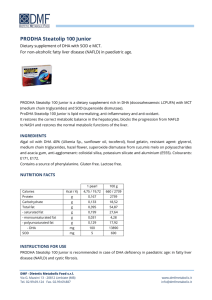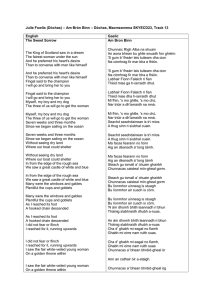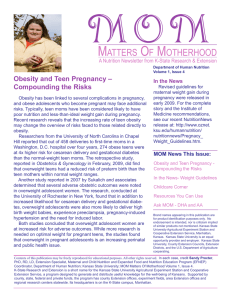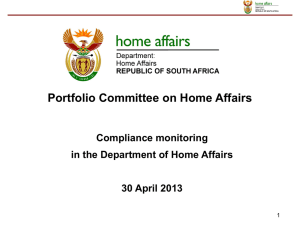MRCGP International Examination
advertisement
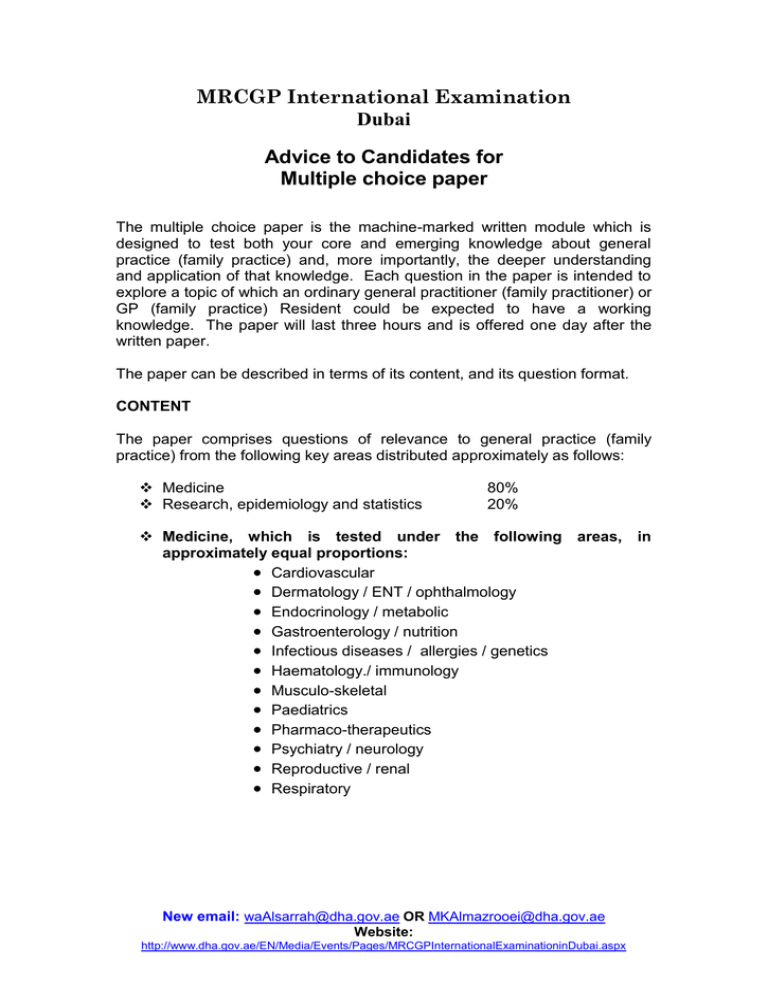
MRCGP International Examination Dubai Advice to Candidates for Multiple choice paper The multiple choice paper is the machine-marked written module which is designed to test both your core and emerging knowledge about general practice (family practice) and, more importantly, the deeper understanding and application of that knowledge. Each question in the paper is intended to explore a topic of which an ordinary general practitioner (family practitioner) or GP (family practice) Resident could be expected to have a working knowledge. The paper will last three hours and is offered one day after the written paper. The paper can be described in terms of its content, and its question format. CONTENT The paper comprises questions of relevance to general practice (family practice) from the following key areas distributed approximately as follows: Medicine Research, epidemiology and statistics 80% 20% Medicine, which is tested under the following areas, in approximately equal proportions: Cardiovascular Dermatology / ENT / ophthalmology Endocrinology / metabolic Gastroenterology / nutrition Infectious diseases / allergies / genetics Haematology./ immunology Musculo-skeletal Paediatrics Pharmaco-therapeutics Psychiatry / neurology Reproductive / renal Respiratory New email: waAlsarrah@dha.gov.ae OR MKAlmazrooei@dha.gov.ae Website: http://www.dha.gov.ae/EN/Media/Events/Pages/MRCGPInternationalExaminationinDubai.aspx Research, epidemiology and statistics, including : Assessing the quality of care Principles of audit Understanding and application of the terms used in inferential statistics and evidence-based medicine Knowledge of statistics and research methodology, sufficient for the critical appraisal of published papers. The number of items in each of these main headings areas is constantly under review and inevitably there is some overlap between them Questions are derived from accredited and referenced sources, including review articles and original papers in journals readily available to all general practitioners and family physicians: primarily from Clinical Evidence, British Medical Journal, British Journal of General practice, Drugs and Therapeutics Bulletin ,American Family physician, Australian & Canadian family medicine journals or Cochrane Reviews. Occasionally a question may use original material from published papers, and the item may take longer to complete. This variation in question time will have been taken into account in constructing the total paper. The current edition of the British National Formulary is the reference source for therapeutics questions, including the general information on prescribing. Some questions may refer to the unlicensed but widely accepted use of specific drugs. Some of these questions relate to current best practice. They should be answered in relation to published evidence and not according to an individual’s local arrangements. Calculators are NOT necessary for statistical questions, and so are NOT allowed in the examination. Pictorial data such as charts, risk charts and photographs may be included in the questions. FORMAT The paper contains a number of different formats of questions including some or all of the following: Extended Matching Questions (EMQ) in which a scenario has to be matched to an answer from a list of options. You may feel that there are several possible answers but you must choose only the most likely from the option list. New email: waAlsarrah@dha.gov.ae OR MKAlmazrooei@dha.gov.ae Website: http://www.dha.gov.ae/EN/Media/Events/Pages/MRCGPInternationalExaminationinDubai.aspx For example: THEME: Reduced Vision Option list: (A) Basilar migraine (B) Cerebral tumour (C) Cranial arteritis (D) Macular degeneration (E) Occlusion of the central retinal artery (F) Occlusion of the central retinal vein (G) Optic neuritis (H) Retinal detachment (I) Tobacco optic neuropathy Instruction: For each patient with reduced vision below, select the single most likely diagnosis from the list above. Each option may be used once, more than once, or not at all. Items: 1 A 75-year-old man, who is a heavy smoker, with blood pressure of 170/105, complains of floaters in the right eye for many months and flashing lights in bright sunshine. He has now noticed a ‘curtain’ across the vision of his right eye. 2 A 70-year-old woman complains of shadows, which sometimes obscure her vision for a few minutes. She has felt unwell recently with loss of weight and face pain when chewing food. 3 A 45-year-old woman, who is a heavy smoker, with blood pressure of 170/110, complains of impaired vision in the left eye. She has difficulty discriminating colours and has noticed that her eye aches when looking to the side. Single Best Answer (SBA) questions in which a statement or stem is followed by a variable number of items, only one of which is correct. For example: In the management of croup in a 2-year-old child, which single best treatment has been shown in randomised controlled clinical trials to shorten the course of the condition? A B C D E F Place the child in a steam filled bathroom Administer inhaled budesonide Prescribe amoxicillin 125 mg t.d.s. for five days Administer inhaled salbutamol Prescribe paediatric cough suppressant containing codeine Administer inhaled tribavirin may or may not be included New email: waAlsarrah@dha.gov.ae OR MKAlmazrooei@dha.gov.ae Website: http://www.dha.gov.ae/EN/Media/Events/Pages/MRCGPInternationalExaminationinDubai.aspx Table/Algorithm Completion This is the format often found in guidelines to advise on management decisions. You are asked to select the correct answer to complete the table or algorithm box. A simple example is shown below Medical management of menorrhagia Not requiring contraception 1 ------- Requiring contraception 2 ------- Combined oral contraceptive pill 3 --------- For each of the numbered gaps above, select ONE option from the list below to complete the algorithm, based on current evidence. Select ONE option only A B C D E F G H I Copper intra-uterine device Cyclical medroxyprogesterone acetate Cyclical norethisterone Inert intra-uterine device Levonorgestrel releasing intra-uterine system Mefenamic acid Nonoxinol ‘9’ Tibolone Tranexamic acid The number of items in each format is variable. The maximum number of items in the paper will be 200. Use of conventional terms Every effort is made to ensure that the wording of questions is as clear and unambiguous as possible. It is important that candidates understand the meanings of certain conventional terms which appear frequently: Pathognomonic, Diagnostic, Characteristic and In the vast majority imply that a feature would occur in at least 90% of cases. New email: waAlsarrah@dha.gov.ae OR MKAlmazrooei@dha.gov.ae Website: http://www.dha.gov.ae/EN/Media/Events/Pages/MRCGPInternationalExaminationinDubai.aspx Typically, Frequently, Significantly, Commonly and In a substantial majority imply that a feature would occur in at least 60% of cases. In the majority implies that a feature occurs in greater than 50% of cases. In the minority implies that a feature occurs in less than 50% of cases. Low chance and In a substantial minority imply that a feature may occur in up to 30% of cases. Has been shown, Recognised and Reported all refer to evidence which can be found in an authoritative medical text. None of these terms makes any implication about the frequency with which the feature occurs. These definitions are reproduced in the introduction to the examination paper. Scoring Irrespective of the question format, candidates are awarded one mark for each item answered correctly. Marks are not deducted for incorrect answers nor for failure to answer; the total score on the paper is the number of correct answers given. You are therefore advised to attempt all items. For most questions you must give the single best answer. If you enter more than the required number of answers for a question, no marks will be awarded for that question. Your answers are recorded on machine-marked sheets. If it is helpful, you may mark the question booklet as a preliminary before completing the answer sheets. If you do this, remember to leave sufficient time in which to transfer your answers. You will not be allowed extra time for this. Use only the pencil provided. On each of the answer sheets: Write your name in the spaces provided Enter your candidate number in the five boxes provided and fill in the appropriate lozenges. Record your answers on the appropriate answer sheet by making a heavy black mark that fills the lozenge containing the letter which corresponds to your choice of answer. If you simply mark with a faint horizontal line the mark will not be detected and you will receive no mark. You may erase answers using the rubber provided. New email: waAlsarrah@dha.gov.ae OR MKAlmazrooei@dha.gov.ae Website: http://www.dha.gov.ae/EN/Media/Events/Pages/MRCGPInternationalExaminationinDubai.aspx
